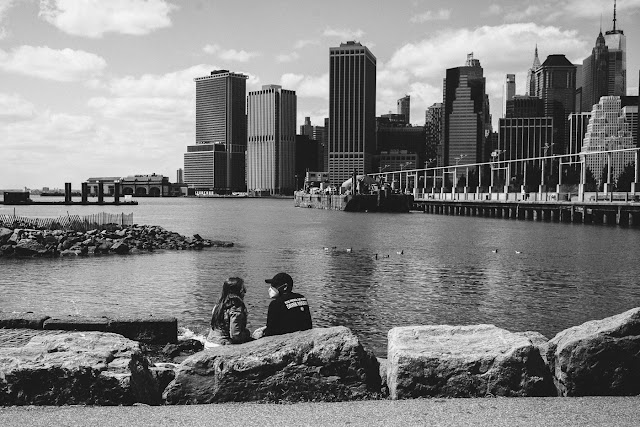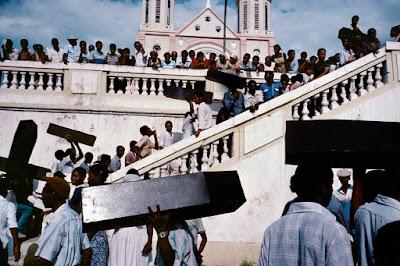Too Many Lenses, Too Few Eyes - Lens Blog - NYTimes.com
We photographers know all to well the effect this has had for us photojournalists. No matter where you find yourself; be it remote countrysides, poverty stricken slums, or battle torn streets, people have become more aware of the camera and what it does. People that once where indifferent to the box around your neck are all too aware and self conscious regarding the power of the picture. Some ask for money, some sheepishly turn away and others scream in rage at the intrusion on their privacy. It has become increasingly difficult to get that candid shot or eyes filled with the emotion of the moment. We photographers, professional or amateur need to become more aware of our methods. We need to lessen the impact our presence and our camera has on the people and the story we are trying to document. We are here(or there) to record a moment, emotional or physical, not to impact it. We must be sensitive to our surroundings and the situations we find ourselves in. Keep the ripples our steps make at a minimum and remember the "fly on the wall" approach.
Written by Seth Mydans for lens blog New York Times.
BANGKOK — For many travelers, the goal of tourism now seems as much to be recording the trip as living the experience.
This impulse is neatly captured in a photograph by Lydie France of the European Pressphoto Agency that shows a crowd of people around the Mona Lisa, several of them holding up small cameras for snapshots. Why? Who needs a snapshot of the Mona Lisa? Why not just look and appreciate? The camera seems to form a barrier between the viewer and the experience.
But perhaps the creative act of taking a picture, whatever its quality, can connect a person with a subject in a more personal, interactive way. Maybe it simply says, “Hey, I was there.” In any case, the spread of cameras has made tourism — from museums to mountains — a less passive pursuit than in the past, for travelers and subjects alike.
A new documentary, “Camera, Camera,” begins with a shot of the Laotian countryside as seen on the viewing screen of a small camera. As it proceeds, the film alternates between vistas of rural Laos in its natural beauty and the viewing-screen versions of those vistas. This duplicates the experience of many travelers today, who compose their experience through camera lenses as they go and then take the pixelated images home with them in place of memories.
Seeking to present familiar subjects in a new way, some news photography today comes close to being art, capturing a viewer’s eye — even challenging the viewer — with imaginative compositions. I’ve been surprised to see how far this can go in pictures where it takes a little work to make out the actual subject.
As photojournalists have greater license to be artists, reporters similarly have more latitude to be “writers” — not simply recorders of fact. Many subjects call out for new, imaginative presentation. I used to believe that the writer should not intrude between the reader and the subject, but should step aside and present the subject matter unadorned. (I did start out at a wire service, The Associated Press.) It’s been a great pleasure to feel I’ve been liberated to try to bring more of myself into my writing.
It is the sadder side of these changes that “Camera, Camera” presents. As the world has become familiar to us, we have lost something valuable in human experience: adventure, discovery, exploration of the unknown. (The “adventure travelers” in the film rent inner tubes to float down the Mekong River and pay to swing above it on ropes.)
I was reminded of Khaosan Road in Bangkok, which I once described as “the black hole at the center of a shrinking world where the Age of Discovery has ended, all roads have been traveled and the words ‘remote’ and ‘exotic’ have all but lost their meaning.” (“Bangkok Journal; Bit of Trekkers’ Exotica, Looking More Like Home,” May 12, 2001.) The world of travel has been tamed.
Meanwhile, the world as a whole is being altered by the colonization of fragile cultures by camera-carrying travelers.
“Camera, Camera” captures one of the most disturbing examples I know of the way tourists can overwhelm their subjects. It is the scene of what once was a heart-stopping moment in the ancient town of Luang Prabang: the early morning procession of hundreds of barefoot monks in their bright orange robes, carrying begging bowls. (“Tourism Saves a Laotian City but Saps Its Buddhist Spirit,” April 15, 2008.)
As the film shows, this sacred ritual is now swarmed by scores of bustling tourists, some of whom lean in with cameras and flashes for closeups as the monks pad silently past. “Now we see the safari,” a local artist, Nithakhong Somsanith, told me bitterly. “They come in buses. They look at the monks the same as a monkey, a buffalo. It is theater. Now the monks have no space to meditate, no space for quiet.”
Seth Mydans, who is based in Bangkok, covers Southeast Asia for The New York Times and The International Herald Tribune. His father was among the first photographers hired by Life magazine, in 1936.
Marlon Krieger
Check out "Camera, Camera" a film by Malcolm Murray and the below article in Lens Blog
Written by Seth Mydans for lens blog New York Times.
BANGKOK — For many travelers, the goal of tourism now seems as much to be recording the trip as living the experience.
This impulse is neatly captured in a photograph by Lydie France of the European Pressphoto Agency that shows a crowd of people around the Mona Lisa, several of them holding up small cameras for snapshots. Why? Who needs a snapshot of the Mona Lisa? Why not just look and appreciate? The camera seems to form a barrier between the viewer and the experience.
But perhaps the creative act of taking a picture, whatever its quality, can connect a person with a subject in a more personal, interactive way. Maybe it simply says, “Hey, I was there.” In any case, the spread of cameras has made tourism — from museums to mountains — a less passive pursuit than in the past, for travelers and subjects alike.
A new documentary, “Camera, Camera,” begins with a shot of the Laotian countryside as seen on the viewing screen of a small camera. As it proceeds, the film alternates between vistas of rural Laos in its natural beauty and the viewing-screen versions of those vistas. This duplicates the experience of many travelers today, who compose their experience through camera lenses as they go and then take the pixelated images home with them in place of memories.
["Camera, Camera" was directed by Malcolm Murray, written by Michael Meyer and produced by Josh Haner, who is a co-editor of the Lens blog and has photographed Laos for The Times.]With cameras everywhere, one of the challenges photojournalists face is finding new ways to present familiar scenes. When my father, Carl Mydans, was shooting for Life magazine, pictures of combat, disasters and exotic locales were novel to most readers and carried their own power. Now, many such scenes have lost their freshness and impact.
Seeking to present familiar subjects in a new way, some news photography today comes close to being art, capturing a viewer’s eye — even challenging the viewer — with imaginative compositions. I’ve been surprised to see how far this can go in pictures where it takes a little work to make out the actual subject.
As photojournalists have greater license to be artists, reporters similarly have more latitude to be “writers” — not simply recorders of fact. Many subjects call out for new, imaginative presentation. I used to believe that the writer should not intrude between the reader and the subject, but should step aside and present the subject matter unadorned. (I did start out at a wire service, The Associated Press.) It’s been a great pleasure to feel I’ve been liberated to try to bring more of myself into my writing.
It is the sadder side of these changes that “Camera, Camera” presents. As the world has become familiar to us, we have lost something valuable in human experience: adventure, discovery, exploration of the unknown. (The “adventure travelers” in the film rent inner tubes to float down the Mekong River and pay to swing above it on ropes.)
I was reminded of Khaosan Road in Bangkok, which I once described as “the black hole at the center of a shrinking world where the Age of Discovery has ended, all roads have been traveled and the words ‘remote’ and ‘exotic’ have all but lost their meaning.” (“Bangkok Journal; Bit of Trekkers’ Exotica, Looking More Like Home,” May 12, 2001.) The world of travel has been tamed.
Meanwhile, the world as a whole is being altered by the colonization of fragile cultures by camera-carrying travelers.
“Camera, Camera” captures one of the most disturbing examples I know of the way tourists can overwhelm their subjects. It is the scene of what once was a heart-stopping moment in the ancient town of Luang Prabang: the early morning procession of hundreds of barefoot monks in their bright orange robes, carrying begging bowls. (“Tourism Saves a Laotian City but Saps Its Buddhist Spirit,” April 15, 2008.)
As the film shows, this sacred ritual is now swarmed by scores of bustling tourists, some of whom lean in with cameras and flashes for closeups as the monks pad silently past. “Now we see the safari,” a local artist, Nithakhong Somsanith, told me bitterly. “They come in buses. They look at the monks the same as a monkey, a buffalo. It is theater. Now the monks have no space to meditate, no space for quiet.”
Seth Mydans, who is based in Bangkok, covers Southeast Asia for The New York Times and The International Herald Tribune. His father was among the first photographers hired by Life magazine, in 1936.



